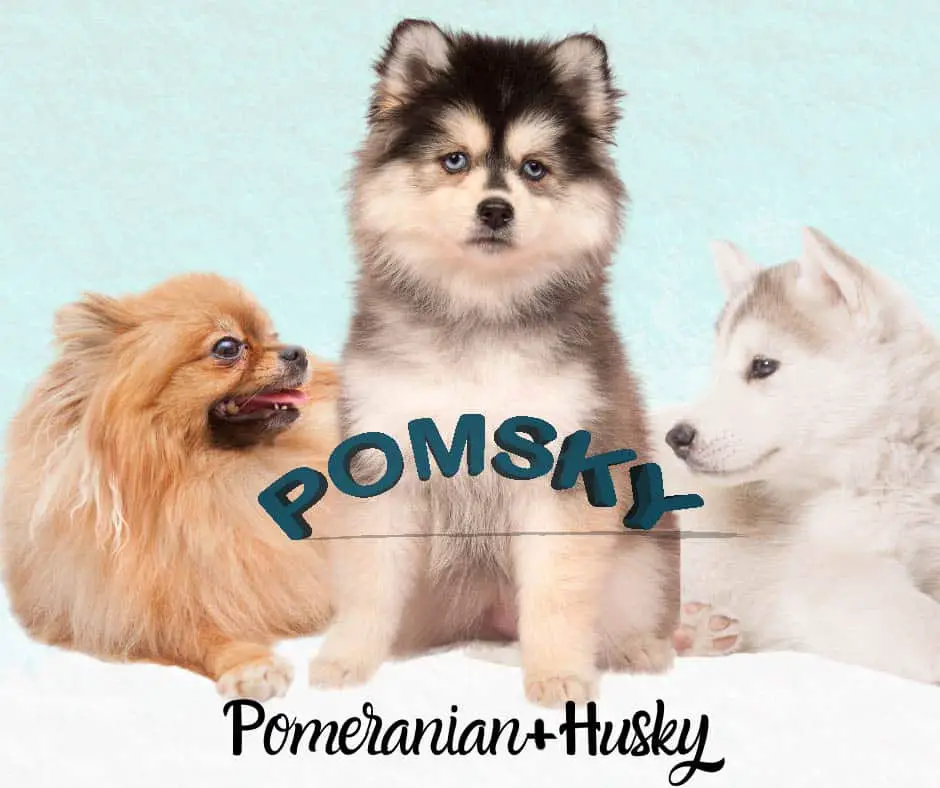
Given the increasing popularity of Siberian Huskies, it is no surprise to see experimentation with cross-breeding them with other dog breeds, especially a smaller size.
A Pomeranian Husky, also known as a Pomsky, is a crossbreed between a Siberian Husky and a Pomeranian. They’re known as designer dogs due to their hybrid nature. They usually look similar to a smaller version of a pure Husky breed, while also inheriting the furry side of the Pomeranian breed.
They are generally noted for their playful and fun nature, while their compact size makes them perfect lap dogs!
As they are prized for their adorable looks, enthusiasts are still trying to make sure their looks gravitate towards the Husky’s side, rather than its Pomeranian counterpart. If you would like to know all about this wonderfully unique breed of dogs, keep reading!
The breed is not recognized by the American Kennel Club and is unlikely to do so anytime soon, not until the breed establishes a presence and has consistency after generations of breeding. A Pomsky can be expected to grow to around 25 pounds, which in comparison to the Husky's 35-60 pounds is quite small, but still larger than many toy dogs.
Origin of Pomskies
It is believed that Pomskies originated in 2009 in the United States. They are the result of crossing a Siberian Husky with a Pomeranian.
The Siberian Husky is known to have belonged to an ancient Siberian tribe known as the Chukchis. It was in 1908 that these dogs gained popularity in Alaska for their wolf-like features and were mainly used as sled dogs. Later on, they became domesticated dogs that were kept as pets.
On the other hand, Pomeranians are known to have descended from larger dogs that belonged to a type called the German Spitz. The breed of Pomeranians was so popular that they have always found a home in royal households.
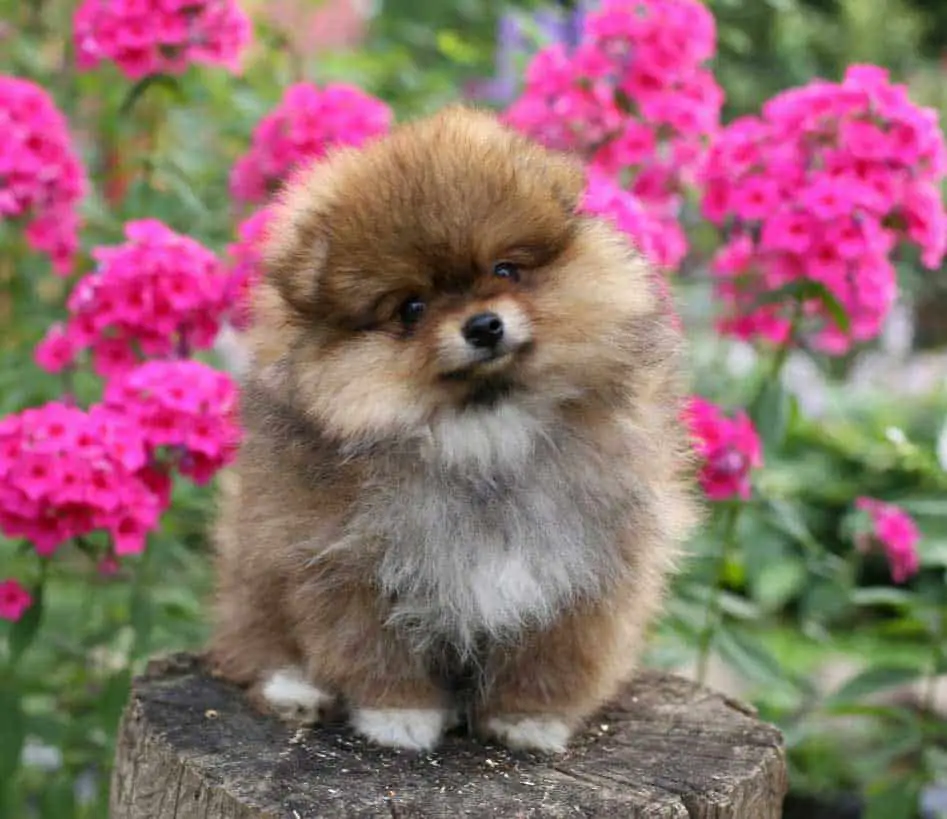
Pomeranian puppy
Pomsky breed is not recognized by the American Kennel Club and is unlikely to do so anytime soon, not until it establishes a presence and has consistency after generations of breeding.
Size Variations
Pomskies are generally on the smaller side when compared to the average dog size, but can sometimes grow to medium size, depending on which dominant side they take after (Husky or Pomeranian).
They are usually 10 to 15 inches tall (25 to 38 cm), and can be expected to grow to avarage 28 pounds, which in comparison to the Husky's avarage 51 pounds is quite small, but still larger than many toy dogs. The weight range of Pomsky is quite broad and sometimes
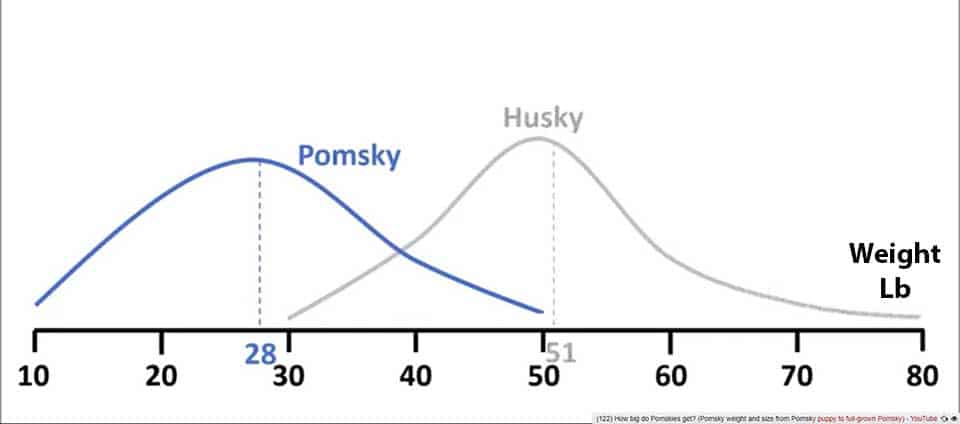
Weight graphs: Pomsky in comparison to Husky
Appearance of Pomskies
Pomskies come in a wide range of colors such as white, black, grey, brown, and off-white. They have a silky coat of fur and also have pointed ears. They are quite muscular for their size with strong legs, and they also are the owners of wide, sturdy shoulders. It is a common fact that female Pomskies are slightly smaller and lighter than male Pomskies.
It will take at least a few more years of breeding Pomksies to understand what a typical one will look like and behave.
Pomsky Generation Types - F1 and F2
The two most popular types of Pomskies are the F1 and F2 types. This depends on nothing but the parentage of the Pomsky.
There are few more additional types known as F3, F1B, and F1X, but these are not as common as F1 and F2.
Let’s take a look at the two most common types of Pomskies and their benefits:
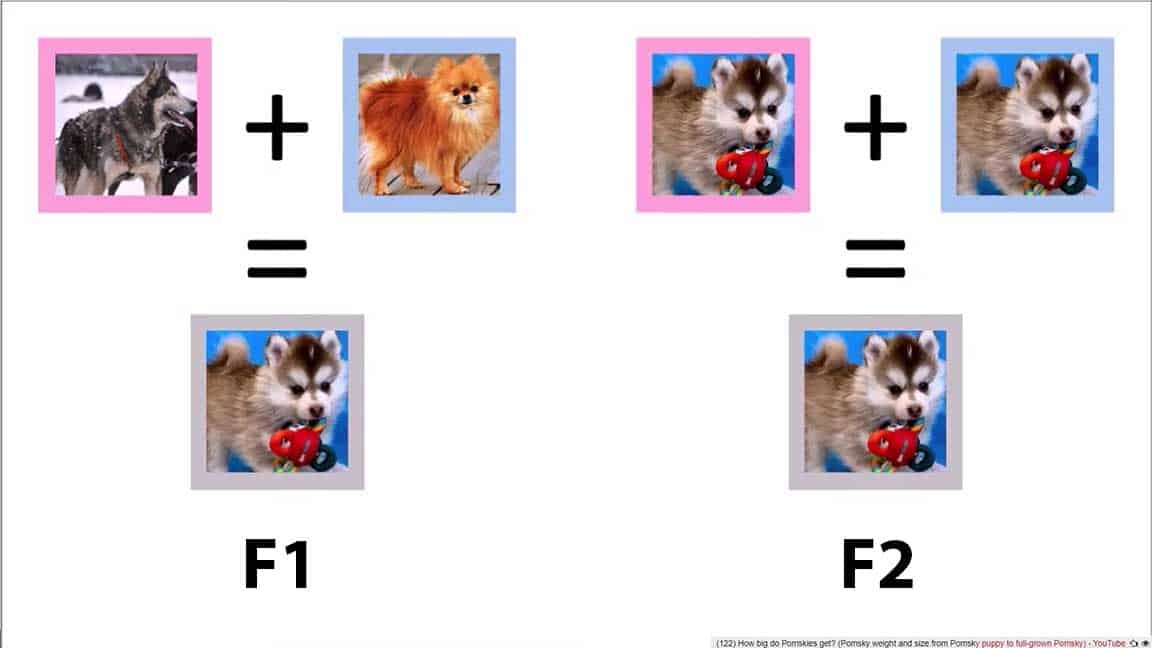
F1 Pomsky:
A Pomsky is referred to as F1 when its mother is a Husky and father is a Pomeranian. This can never be reversed (which means that the father cannot be a Husky and the mother a Pomeranian) as the mother always has to be bigger in size.
F2 Pomsky:
When both the parents happen to be F1 Pomskies, their puppy is called an F2 Pomsky.
In general, Pomskies who are F1 generation (purebred Siberian Husky and purebred Pomeranian) tend to cost less than puppies resulting from the mating of two Pomskies (F2 generation).
General Health of Pomskies
Although crossbred dogs are conventionally believed to be immune to all health disorders, studies show that this definitely is not the case.
According to a study conducted by the University of California, Davis, crossbred dogs are just as likely as purebred dogs to get inherited genetic disorders. Hence, you cannot rely on the common myth that crossbred dogs are hardier and don’t face the problem of genetic disorders.
A few of the most common diseases you may want to look out for are Patellar Luxation, allergies, eye problems, and dental cavities. However, these diseases are common to almost all dogs and are not necessarily life-threatening.
The best way to ensure that your Pomsky does not suffer from any of these diseases is to make sure you feed him a nutritious diet that suits his body. You can also take him for regular visits to the vet even if he seems to be healthy on the surface.
Additionally, It goes without saying that vaccines are a necessity for the overall health of your Pomsky and must not be overlooked.
Lifespan of a Pomsky
A Pomsky’s lifespan usually ranges between 13-15 years, which is a common lifespan among all medium-sized dogs. Pomeranians can live up to 16 years, and a Husky’s life expectancy is between 12-14 years. A Pomsky’s lifespan is typically somewhere between both of these breeds’ lifespans.
Average Price of a Pomsky
There are quite a few variations in the price range depending on the physical features of the Pomsky, such as size, eye color, fur color, pedigree, and quality. On average, the price range is between $2000 - $4000.
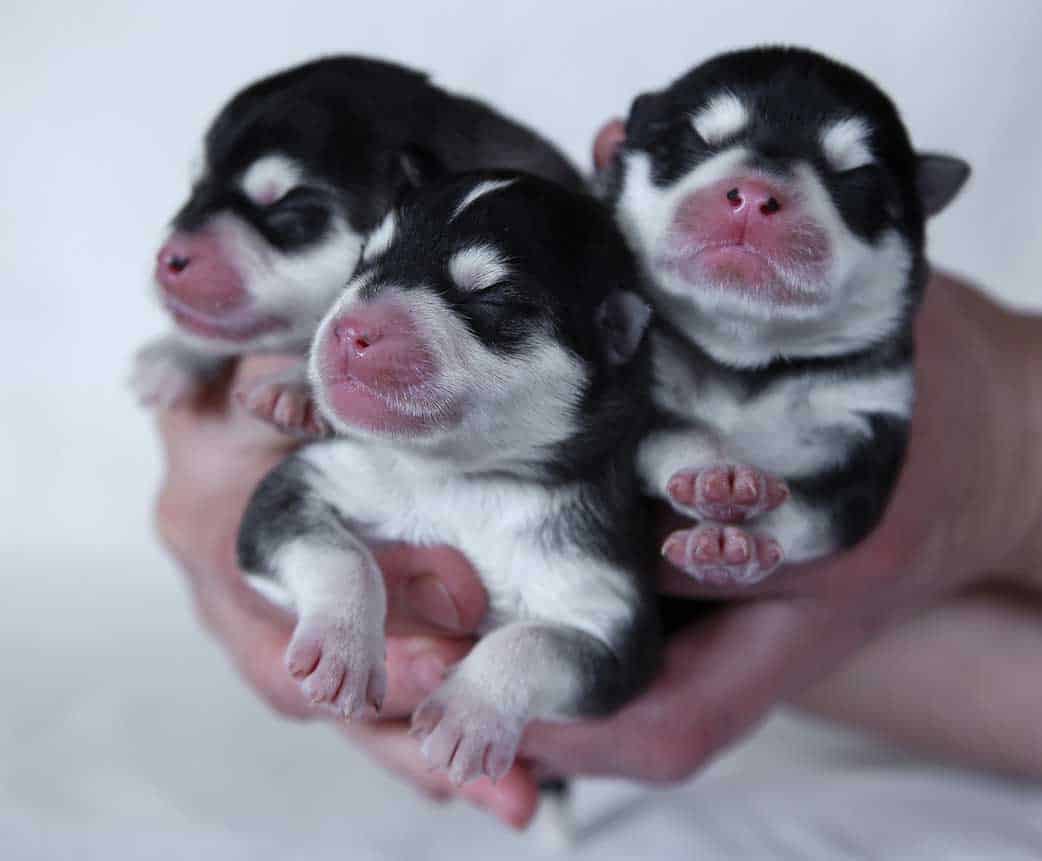
New born Pomsky puppies
Typically, many breeders charge more for a Pomsky that has well-defined Husky features, as they tend to be more in demand. People love Pomskies that have striking eyes and prominent black and white markings that lean towards its Siberian parent, thereby making the cost shoot up as well. They are a niche breed with a limited supply.
Nutrition and Diet
All dogs require a wholesome diet that gives them the right amount of protein, fats, carbohydrates, fibers, vitamins, and minerals. When choosing the diet of your Pomsky, the first thing you need to take into consideration is his size. Pomskies typically come under the category of small-breed dogs.
If you are unsure about the calorie intake for your Pomsky, you can use a reliable online calculator like Pet Nutrition Alliance, which will help you with nutritional assessments and recommendations.
Since Pomskies almost always come under the small-breed category, you can consider using high-quality small-breed dog food.
If you have a Pomsky puppy, you can make use of a good small-breed dog formula and switch over to dog food after a few months, which is usually when the puppy is 7 to 9 months old.
Here is my recommended list of the most nutritious small-breed dog foods:
Nature and Temperament
Since Pomskies are still an evolving breed, there has not been solid evidence to give much depth to any study on their temperaments, traits, nature, and characteristics.
Whereas the Pomeranian has a loyal and playful toy dog temperament that bonds closely with his/her owner, the Husky's temperament is more independent and demands leadership.
So what an offspring of the two will be? Nobody knows. The Pomsky breed is still being established and it isn't clear what kind of dog a Pomsky puppy will grow into, no matter how careful the breeder has been in selecting parents.
It's a reasonable chance that some of the traits of a Husky will come through, such as demanding direction and lots of play and exercise to keep it happy.
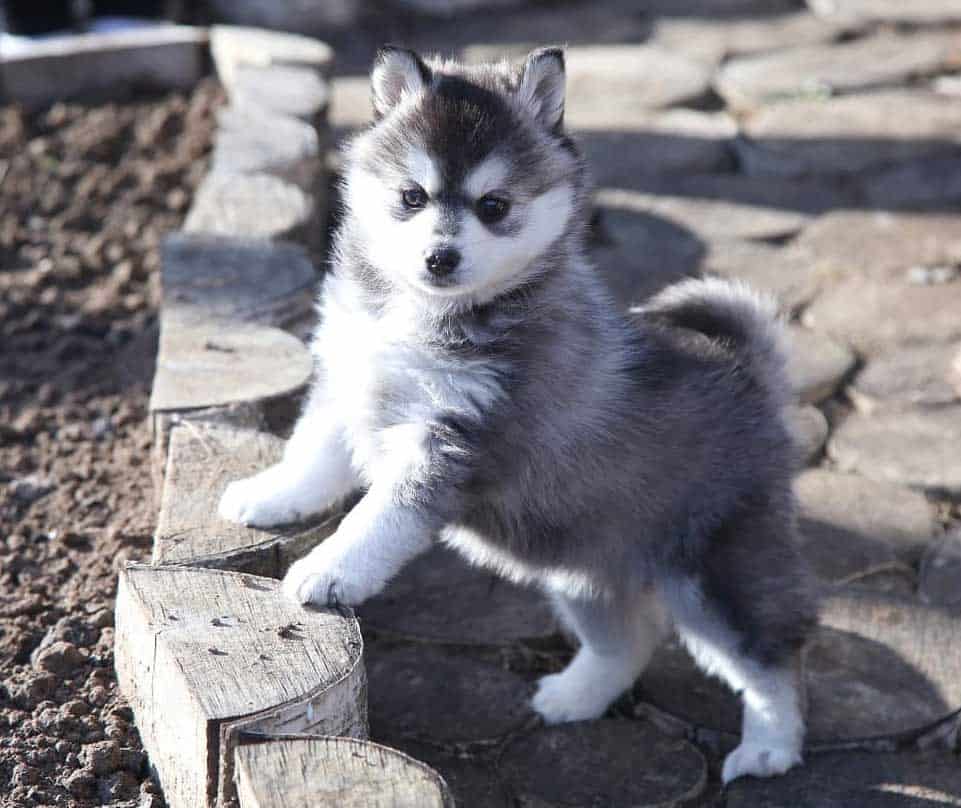
F1 Pomsky puppy
However, Pomskies are generally known to be friendly and extremely playful. They enjoy the company and love playing, making them ideal for a home with a large family. They are not known to be aggressive or irritable.
It is also worth noting that Pomeranians are highly intelligent watchdogs and tend to be wary of strangers. These traits have been noticed in Pomskies as well. When they feel threatened or afraid, they can become aggressive like Pomeranians, but this also depends on the way they have been trained and brought up.
Training a Pomsky
Pomskies inherit their intelligence from both Siberian Huskies and Pomeranians, making them very responsive to training and teaching. It is good to try reward-based training for your Pomsky as it not only is a good method of training but is also known to increase the bond between a master and his pet.
Reward-based training simply means that for every order obeyed, you give your Pomsky a treat to let him know what’s pleasing to you and what is not. Verbal encouragement is also another way to let your Pomsky know that you’re happy with his behavior. This positive reinforcement enhances the relationship you share with your pet companion.
When you train him using this method, you can make use of dog treats. I did some research around Pomsky community and the owners report that Pomsky can be very picky regarding treats. So I would recommend to experiment with different brands and flavours.
Related: Best Snacks and Treats for Husky Puppy
Costs of Owning a Pomsky
You need to remember that buying your Pomsky does not include the total amount you will spend on your pet. Owners need to know that caring for a pet can be a handful and be quite heavy on the pocket as well.
Here is a list of things you will need to spend money on once you have bought a Pomsky:
- Food: Dog food is something you will be spending quite a lot of money on each month. Estimate cost - 500$
- Health and hygiene: Your Pomsky will need regular check-ups to maintain good health and will also require vaccinations. Apart from this, you will need to spend money on bathing requirements, toothpaste and brushes, grooming materials, and occasional medications.
- Toys and accessories: This may seem insignificant, but chew toys and soft toys will need to be replaced once your Pomsky eventually rips them apart. You will also need to buy a leash and dog collar. The estimated cost - around 400$ per year
- Daycare: If you happen to be working a 9-5 job and there is no one else at home, you may need to consider dog daycare. Expect to pay between 21$ to 60$ per day, depends on what state you are residing.
- Dog walker: If you work full-time and have absolutely no time to take your dog outside, you may have to hire a dog walker. Although this may seem a little extra, you never know when you may need it once you become a full-time dog owner who also works a full-time job. Dog walkers charge around 15$ to 25$ for 30 min walk.
Judging by the list above, it is wise to set aside a budget for the next year at least 2000$ and keep in mind emergencies as well.
Grooming Your Pomsky
Pomeranian Huskies are known as designer dogs and require additional care and attention with regard to their health and grooming.
Regular coat shedding is also very likely so Grooming requirements of Pomsky can be higher than a purebred Pomeranian. It will take at least a few more years of breeding Pomksies to understand what a typical one will look like and behave.
There are three essential areas of grooming your Pomsky, which you must not neglect for the sake of the well-being of your dog. These include combing his fur, brushing his teeth, and trimming his nails. Let’s look at these in detail.
Maintenance of Fur Coat
Just like Pomeranians, Pomskies are also known for their luscious coat of fur. On the downside, they are also known for shedding this fur notoriously if left ungroomed.
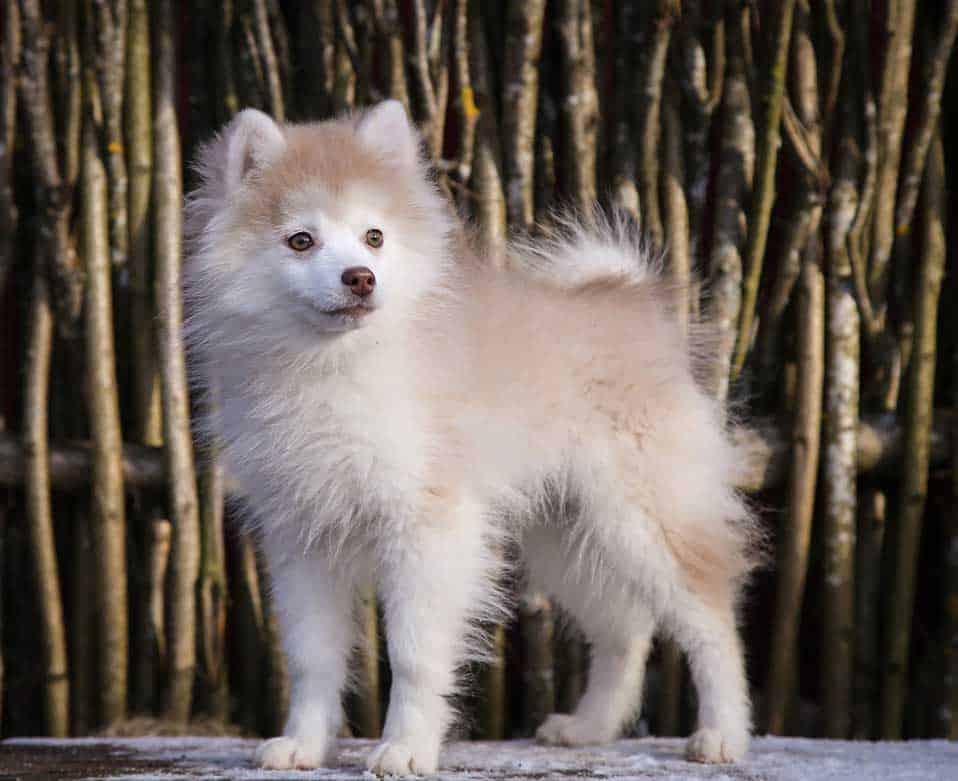
To avoid your Pomsky’s fur getting all over your furniture, it is essential to brush its fur on a regular basis. This promotes the growth of healthy and shiny hair. If left ungroomed, your Pomsky’s beautiful coat can end up looking mangled and haggard.
You might want to check out grooming guide for huskies and husky mixed breeds.
Dental Care
As mentioned earlier, Pomskies are prone to have dental problems. Due to their susceptibility, it is wise to brush their teeth on a daily basis. Brushing your Pomsky’s teeth for the first time can be a difficult task, so it is advisable to read proper instructions from an expert before you begin.
If you haven’t had a dog before, it may surprise you to know that dogs have special dental appliances that make this process easier. If you feel clueless, you can buy a full dental kit like this Arm & Hammer for Pets Tartar Control Kit.
Trimming Nails
Apart from this, you will have to trim your Pomsky’s paw nails at least once in two months as they tend to grow long. Owners often neglect this aspect of grooming, but it certainly is an essential procedure as long nails can lead to many consequences if left untrimmed.
Apart from these main procedures, you will also need to clean their ears and bathe them once a month.
You might want to check out grooming guide for huskies and husky mixed breeds.
Exercise Requirements
Pomskies are extremely playful and have a high amount of energy. Exercising your Pomsky can be done in a variety of ways. They generally love going on walks (as all dogs do) and also enjoy games that give them physical exercise along with their owner’s attention. It is recommended to engage your Pomsky in exercise for at least one hour a day. Not being physically active can lead to negative behavioral traits in your dog.
Playing fetch is one of the most common games which dog-owners and dogs love alike. It’s also a great idea to invest in some toys for your Pomsky as dogs generally dote on toys you give them. If you live in a house with a fence, let your Pomsky roam free outside the house for a while to exert his energy by himself.
Is Pomsky Good Apartment Dog?
While some dogs might find it difficult to live in an apartment, Pomskies are known to be quite adaptable to their surroundings and can most definitely thrive in an apartment building. In fact, most owners of Pomskies seem to reside in apartments.
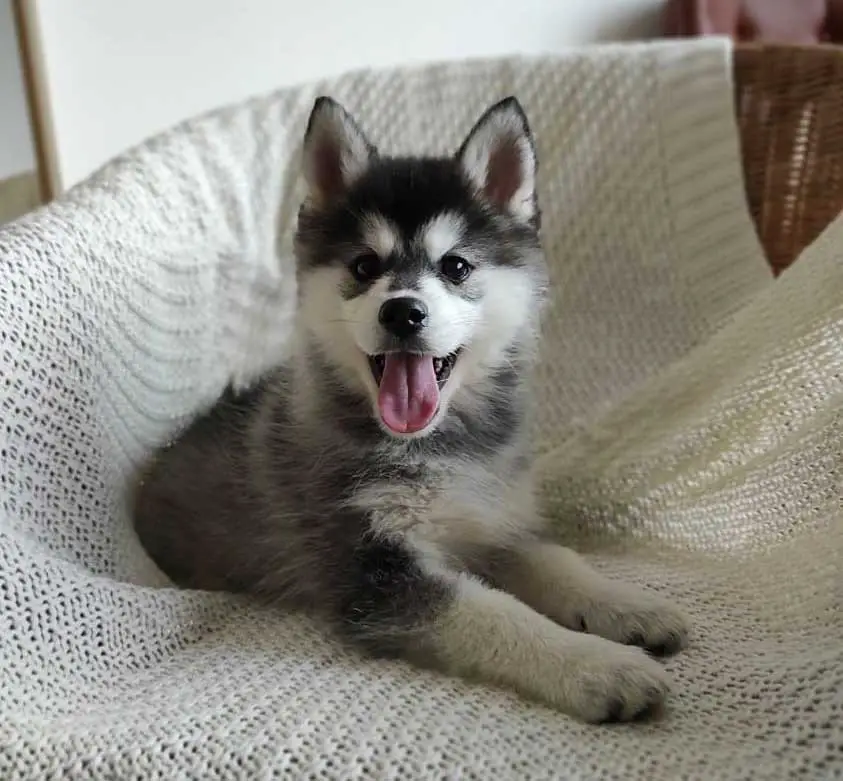
Ideal Climates for Pomskies
It is a known fact that not all dogs can survive in both hot and cold regions. Some dogs belong in cool places due to the presence of a thick coat of fur. A Pomsky is one such dog, who owns a warm coat of fur that can withstand cold climates. Although a Pomsky will thrive in cool temperatures, it does not necessarily mean that it cannot survive in warm temperatures as well.
Pomskies have a double coat of fur, which insulates them from the cold and this coat works both ways by keeping them warm in winter and cool in summer.
However, if you happen to live in a place that is extremely hot, Pomskies might have trouble adapting to it. In such a case, it is advisable to make sure your Pomsky can have access to air conditioners, which will prevent them from becoming too hot underneath their fur. Most people who own such dogs install room coolers to make their dogs more comfortable. Hence, with the right precautions in place, your Pomsky can be happy no matter where you live.
Where Can I Find a Pomsky? (Breeders)
Because of the niche nature of the Pomsky and Pomklee breeds, breeders are few and far between. On the upside, this tends to mean that the breeders that do exist are dedicated to the breed and more likely to be reputable. Try this site in your search to find a specialist breeder.
There is a Pomsky Club of America that lists some approved breeders if you are interested in finding out more.
If you aren't quite sure of whether a Pomsky or Pomklee is for you, but still want a husky looking dog in miniature, then look no further than purebreed Miniature Siberian Husky or Alaskan Klee Kai. Go for the Alaskan Klee Kai if you want a smaller dog that will bond closely with you. On the other hand, if you are an active person, who ready for the challenge of training, a Miniature Siberian Husky might better suit your lifestyle.
What is Pomklee?
Like the Pomsky, a Pomklee is a cross between a Pomeranian and an Alaskan Klee Kai. Since the Klee Kai is itself a mixture of breeds and more closely related to the Alaskan Husky, combined with a very limited breeding program, it is hard to pinpoint what a Pomklee should appear or behave like.
In fact, if you saw Pomklees advertised, you should feel skeptical about whether the breeder really knows what they are doing, or whether they are just labeling the animal as Pomklee to make a sale. Such puppy farms should be avoided at all costs! Follow our advice on selecting a Siberian Husky breeder to get what you pay for.
Let us know if you find a breeder who can verify the ancestry. Prices are likely to be similar to Pomsky, if not a little higher. But as we have alluded to, there is little direction in breeding programs for the Pomklee so consider any advertised dog a mixed breed that doesn't have the predictability of a pure breed.
Summary
This article summarizes all that you can expect and be prepared for before you get a Pomsky. Based on the information presented here, you must be able to decide on whether or not a Pomsky is the right choice for you.
One important factor to remember is that every Pomsky is unique and will vary in size, appearance, and temperament. Since this is a long term investment that will require a lot of time, money, and dedication on your part, it is wise to go through all the pros and cons of owning a Pomsky from an objective point of view before making a decision. At the end of the day, they are a remarkable breed and would be lovely companions to have around the house!